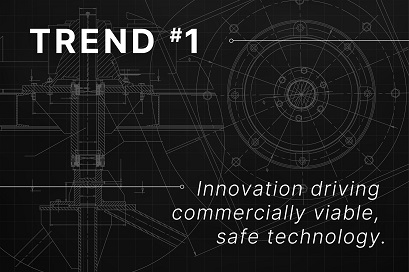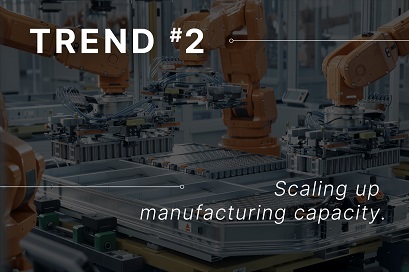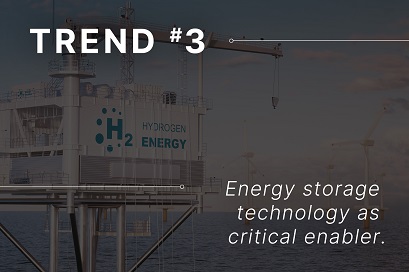As we look back on 2023, it’s clear that some progress has been made to meet climate change goals. We’ve seen some big decisions being made. At COP28, governments agreed to “transition away” from fossil fuels to avert the worst effects of climate change and investment in low-carbon energy technologies surpassed those in fossil fuels for the first time. The IEA stated that it sees the ‘beginning of the end’ for the fossil fuel era. However, maintaining momentum was challenging with continuing geo-political instability driving many countries to prioritize energy stability over the energy transition in the short term. There is clearly a lot still to do to achieve 2050 net zero targets.
As we look forward into the remainder of 2024 and beyond, there’s a lot for the energy industry to consider. It’s evident that sustainable technology will continue to be at the core of the energy management industry and that greater investment is required. Increasing focus on innovation will support the energy transition, push the boundaries of what’s possible and help the world gear up for a low-carbon future. Innovators, product developer and manufacturers can still look forward to new opportunities. We asked our team what they are hearing from the market as we head into 2024.
Here are 4 technology trends industry we’re tracking:
Technology Trends in Energy Industry #1: Innovation Driving Commercial Viable, Safe Technology

Ramie Smith, Sr Dir - Engineering Solutions – EMEA
Existing technologies will take us part of the way to achieving net zero emissions by 2050. However, in areas where it will be difficult or even impossible to achieve net zero emissions with existing decarbonization technology, innovation will be vital. That’s why we expect investment in innovation to continue to accelerate during 2024. Policy developments including the Net Zero Industry Act in the European Union and the Inflation Reduction Act in the United States also have the potential to accelerate innovation as energy technology companies seek to provide technology to drive compliance. It’s clear that technology readiness levels are advancing across all areas of clean energy, but developers need to go further, faster.
The transportation industry, specifically trucking and heavy equipment is one area where innovation is required. The UK is aiming to have all new heavy goods vehicles be zero emission by 2040 and the State of California is targeting for half of all heavy duty truck sales to be fully electric by 2035. In the EU, the European Commission is looking to tighten up CO2 emissions standards for heavy duty vehicles. The industry will need to decide which route to take to achieve that, whether that’s a switch from diesel to hydrogen fuel cells or a combination of electrification and hydrogen fuel cells to provide greater range and less frequent charging.
To deliver new technology to market, enabling solutions need to keep pace with innovation. Manufacturable and commercially viable technology is what’s needed. Utilized effectively, Design for Excellence (DfX) methodologies will help to achieve this. Integrating DFX into development cycles, will prevent surprises in new product introduction, ensure cost control and visibility, and crucially accelerate time to market.
For example if we consider what a hydrogen fueled energy generation and transportation market will look like, applying DFX principles during development will help innovators to build in cost reduction enabling them to bring this new technology to the right price point and achieve mass marketing more speedily.
In addition to DfX methodologies, embedding eco-design principles and focusing on Design for Environment (DfE) will ensure that products have the lowest possible environmental impact throughout their lifecycle. It will be advantageous to consider how to reduce waste and emissions associated with a product’s use, manufacturing processes and end-of-life as early as possible in the product development process.
Another important consideration for innovators is cybersecurity. As innovation accelerates and smarter technology connects to the grid, cybersecurity becomes that much more critical. There are two facets to the issue of cybersecurity to consider. First, the product development and manufacturing —how a partner controls and protects the customer’s information and intellectual property. Then there’s the security of connected products against cyber threats when they’re in use out in the market. Energy technology companies will need to make sure that they’re working with partners who not only understand, but are proactively prepared for today’s cybersecurity needs.
Technology Trends in Energy Industry #2: Scaling up Manufacturing Capacity

Rich Latta, Manufacturing Solutions Director
To continue the energy transition and drive towards global net zero aspirations by 2050, it is pivotal for clean energy technology manufacturing capacity to scale up at pace. Our customers are seeing increasing demand to provide roadside rapid charging for electric vehicles and electrified heavy equipment globally. But it’s clear this trend doesn’t only apply within energy for transportation, it’s across the full breadth of clean energy solutions from generation to energy storage technology and carbon capture.
Those entering new markets or pushing to capture greater market share need to choose how to scale up their engineering, supply chain, manufacturing, order fulfilment and sustaining services capacity:
- Build their own capabilities, team and footprint or
- Work with a partner that has an established manufacturing footprint and expertise.
Deciding which option to select will be influenced by financial considerations; the speed with which products need to get to market; whether any additional support beyond manufacturing is required and quality requirements.
Along with scaling up quickly to meet demand, energy technology companies are committed to operating sustainably and responsibly. Companies want to be able to deliver their products to market with the lowest carbon footprint possible, which is one of the reasons we’re seeing a continuing trend for regional manufacturing solutions coupled with localized supply chains.
Scaling up goes beyond manufacturing. Energy technology companies also need to make sure they develop effective processes for sustaining their products. For example carrying out field repair and having the right parts in place to deliver this in a timely way.
Those developing decarbonization technology need to ensure that manufacturing and sustaining services processes don’t increase the product’s carbon footprint. They need partners and suppliers who share their desire to achieve this. Skip to trend 4 to learn more about this.
Technology Trends in Energy Industry #3: Energy Storage Technology as a Critical Enabler

Mark Mackay, Business Development Director
In 2024 and beyond, energy storage technology and its wider adoption remains a critical enabler to achieving net zero ambitions. This is due to it’s ability to deliver consistent renewable energy supplies to power systems, thereby increasing grid stability, balancing and reliability. Energy storage technology delivers reserve power when demand is high and absorbs excess power when demand is low. Without this technology, renewable energy cannot be harnessed properly and outages could occur when the sun isn’t shining or the wind isn’t blowing.
Short term, day-to-day and longer terms needs will all require different types of energy storage technology to balance supply and demand:
- Short-term boosts to supply will be met by battery technology, as it can react and deploy power rapidly
- Day to day changes could be met by battery technology or by systems such as pumped storage hydro with an ability to absorb and deliver energy from its turbines.
- The need for new technology to deliver long-term solutions and avoid a reliance on fossil fuels.
The challenge for innovators is how to maximize the resources and financial investment they focus on core technology innovation and marketing to win the race to market and maximize their ROI.
Beyond energy storage technology, harvesting energy from renewable sources and converting it into useable power will require the wide deployment of new technologies and investment in national grids. This will include power electronics and high voltage equipment, including HVDC (High Voltage Direct Current Electricity) Systems, automation and protection products and asset management equipment to monitor performance.
AI and machine learning will also have a role to play here within systems to optimize energy systems, forecast supply and demand as well as predictive maintenance and fault detection to name a few.
Technology Trends in Energy Industry #4: Greater Focus on Operating Sustainably and Responsibly
Megan Schleicher, Senior Director – Sustainability
Sustainable and responsible business practices continue to grow across all industries, so it’s inevitable that they are even more important to companies with products that aim to reduce our collective impact on the planet.
- Reducing emissions – With the global focus on climate change more urgent than ever, companies are increasingly focusing on the sustainability and resiliency of their supply chain. This includes seeking to reduce Scope 3 emissions-indirect emissions that occur because of the companies’ operations, but from sources not owned or controlled by the company and de-risk. When bringing new energy management products to market, each member of the supply chain needs to behave in a socially and environmentally responsible way. Reducing Scope 3 emissions within the supply chain is an increasingly important driver for decisions on where to manufacture. Sustainable and responsible sourcing alongside supply chain localization and a focus on logistics will lower overall carbon footprint, transportation and energy requirements, thus ensuring that ‘green’ products do not have a hidden negative impact on our environment.
- Delivery circularity – Decisions made in early product development could also have a hidden negative impact on the planet in the long term. Extending product life cycles as far as possible will require Design for Service methodology to deliver repair and refurbishment simply and a plan for how to upgrade products in the field. Designing for part and resource recovery as well as recyclability will enable innovators to achieve circularity for decarbonization technology and prevent clean technology equipment from ending up in landfill at end of life. Learn more about how to design products for a better world.
- Material challenges – As we move away from reliance on fossil fuels, we will face a number of material challenges, whether that’s the limited availability of silicon carbide to power core module technology for all chargers and vehicles or lithium for batteries. Innovative problem solving will grow in importance. For example, developers are looking at ways to avoid the use of less abundant critical metals while still delivering effective battery chemistry. Others are focusing on how to make use of hydrogen, a naturally abundant gas that can be extracted from garbage or methane leaks. In the short to medium term while alternatives are explored, having the right supply chain in place will help support growth.
Are you ready to make the most of the opportunities?
There will be considerable new opportunities for energy management companies in the short and longer term as the world collectively focuses on decarbonization. You need to make sure you have a strategy that combines agility with a financial and technical solution that will enable you to win your unfair share of these opportunities. Selecting the right partner to support your journey, whether that’s design and development, manufacturing or sustaining services, will provide you with expertise, capability and capacity so that you can maximise your market share, return on investment and minimize your risk.
At Plexus, we have decades of experience and proven success in supporting energy management companies take their products to market. Our vision is to help you create the products that build a better world. If you are ready to talk to Plexus about how we could support your growth, maximize your ROI and develop a more sustainable supply chain, we’re ready to hear from you.